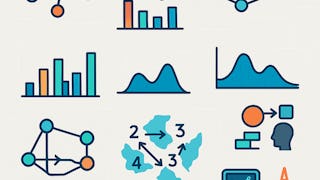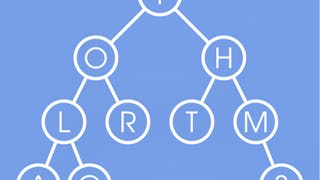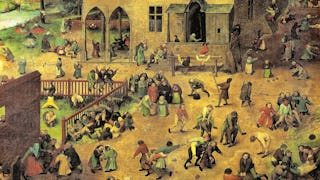We invite you to a fascinating journey into Graph Theory — an area which connects the elegance of painting and the rigor of mathematics; is simple, but not unsophisticated. Graph Theory gives us, both an easy way to pictorially represent many major mathematical results, and insights into the deep theories behind them.

Gain next-level skills with Coursera Plus for $199 (regularly $399). Save now.

Introduction to Graph Theory
This course is part of Introduction to Discrete Mathematics for Computer Science Specialization


Instructors: Alexander S. Kulikov
57,180 already enrolled
Included with
(1,057 reviews)
Skills you'll gain
Details to know

Add to your LinkedIn profile
31 assignments
See how employees at top companies are mastering in-demand skills

Build your subject-matter expertise
- Learn new concepts from industry experts
- Gain a foundational understanding of a subject or tool
- Develop job-relevant skills with hands-on projects
- Earn a shareable career certificate

There are 5 modules in this course
What are graphs? What do we need them for? This week we'll see that a graph is a simple pictorial way to represent almost any relations between objects. We'll see that we use graph applications daily! We'll learn what graphs are, when and how to use them, how to draw graphs, and we'll also see the most important graph classes. We start off with two interactive puzzles. While they may be hard, they demonstrate the power of graph theory very well! If you don't find these puzzles easy, please see the videos and reading materials after them.
What's included
14 videos6 readings5 assignments1 ungraded lab
We’ll consider connected components of a graph and how they can be used to implement a simple program for solving the Guarini puzzle and for proving optimality of a certain protocol. We’ll see how to find a valid ordering of a to-do list or project dependency graph. Finally, we’ll figure out the dramatic difference between seemingly similar Eulerian cycles and Hamiltonian cycles, and we’ll see how they are used in genome assembly!
What's included
12 videos4 readings7 assignments5 ungraded labs
This week we will study three main graph classes: trees, bipartite graphs, and planar graphs. We'll define minimum spanning trees, and then develop an algorithm which finds the cheapest way to connect arbitrary cities. We'll study matchings in bipartite graphs, and see when a set of jobs can be filled by applicants. We'll also learn what planar graphs are, and see when subway stations can be connected without intersections. Stay tuned for more interactive puzzles!
What's included
11 videos4 readings6 assignments2 ungraded labs
We'll focus on the graph parameters and related problems. First, we'll define graph colorings, and see why political maps can be colored in just four colors. Then we will see how cliques and independent sets are related in graphs. Using these notions, we'll prove Ramsey Theorem which states that in a large system, complete disorder is impossible! Finally, we'll study vertex covers, and learn how to find the minimum number of computers which control all network connections.
What's included
14 videos5 readings9 assignments1 ungraded lab
This week we'll develop an algorithm that finds the maximum amount of water which can be routed in a given water supply network. This algorithm is also used in practice for optimization of road traffic and airline scheduling. We'll see how flows in networks are related to matchings in bipartite graphs. We'll then develop an algorithm which finds stable matchings in bipartite graphs. This algorithm solves the problem of matching students with schools, doctors with hospitals, and organ donors with patients. By the end of this week, we'll implement an algorithm which won the Nobel Prize in Economics!
What's included
13 videos6 readings4 assignments
Earn a career certificate
Add this credential to your LinkedIn profile, resume, or CV. Share it on social media and in your performance review.
Instructors


Offered by
Explore more from Algorithms

Birla Institute of Technology & Science, Pilani
 Status: Free Trial
Status: Free TrialUniversity of California San Diego
 Status: Free Trial
Status: Free TrialUniversity of Colorado Boulder
 Status: Preview
Status: PreviewStanford University
Why people choose Coursera for their career




Learner reviews
1,057 reviews
- 5 stars
66.88%
- 4 stars
23.17%
- 3 stars
6.52%
- 2 stars
2.08%
- 1 star
1.32%
Showing 3 of 1057
Reviewed on Dec 31, 2017
This course is interesting, and it is a good introduction. I like the first four weeks' courses, while I feel the last week's course is not clear presented, which changes the instructor.
Reviewed on Mar 9, 2019
The lecturer well explained the course materials. But the assignments are too easy to complete, it does not tease your brain as exercise, and the week 5 is a bit hard to follow
Reviewed on Nov 24, 2017
This course is really good. If someone has interest in graph theory or he wants to learn it, then this course is definitely a good start.
Frequently asked questions
To access the course materials, assignments and to earn a Certificate, you will need to purchase the Certificate experience when you enroll in a course. You can try a Free Trial instead, or apply for Financial Aid. The course may offer 'Full Course, No Certificate' instead. This option lets you see all course materials, submit required assessments, and get a final grade. This also means that you will not be able to purchase a Certificate experience.
When you enroll in the course, you get access to all of the courses in the Specialization, and you earn a certificate when you complete the work. Your electronic Certificate will be added to your Accomplishments page - from there, you can print your Certificate or add it to your LinkedIn profile.
Yes. In select learning programs, you can apply for financial aid or a scholarship if you can’t afford the enrollment fee. If fin aid or scholarship is available for your learning program selection, you’ll find a link to apply on the description page.
More questions
Financial aid available,





